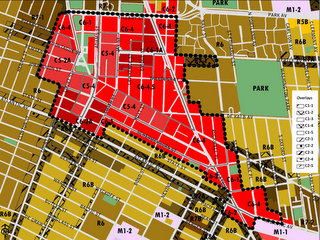
Map of area within the Special Downtown Brooklyn District where revised parking requirements will apply. Credit: DCP.
Proposal to revise residential and public parking rules faces scrutiny on its ability to encourage affordable housing. On November 26, 2012, the City Council’s Zoning & Franchises Subcommittee held a hearing to examine a proposal to amend the parking requirements for the Special Downtown Brooklyn District. The main goal of the proposal, submitted by the Department of City Planning (DCP), is the reduction of required parking sites within the District. The proposal attempts to more accurately reflect car ownership and usage in an area known for its density and rich transit access. Vehicle owners account for 22 percent of the District’s total residents, compared to 45 percent in other areas citywide. Additionally, parking space usage in the District is substantially higher during the daytime than on evenings and weekends. The District is generally bounded by Tillary Street to the north, Atlantic Avenue to the south, Clinton Street to the west, and Ashland Place to the east. Portions of State Street and Atlantic Avenue are excluded from the proposal. The DCP concluded that existing residential parking is underutilized. DCP argues that requirements to provide residential parking places unnecessary costs on developers, with each space costing approximately $50,000.
At the heart of the proposal is a reduction in the amount of accessory parking that residential developers are required to provide for its tenants. Accessory parking is parking spaces provided for users of a specific building. Accessory parking spaces account for 10 percent of the total available parking spaces in Downtown Brooklyn, with 90 percent of spaces in public garages and lots. DCP proposed that developers of new residential buildings be required to provide accessory parking spaces for at least 20 percent of its total units, instead of 40 percent as the Zoning Resolution currently requires. The DCP’s proposal would eliminate accessory parking requirements for affordable housing units in an effort to encourage new developers to include affordable housing in developments. The proposal also states that developers may satisfy accessory parking requirements by providing off-site parking in a public or accessory garage within 2,500 feet of its development. The proposal would also seek to facilitate additional public parking by allowing all accessory parking garage owners within the District to offer unused spaces to the general public or as off-site accessory parking for new developments. Owners may also build up to a 225-space public parking garage below street level as of right. The proposal further imposes new technical rules for public parking garages, including stop sign and speed bump requirements at exits.
Brooklyn Borough President Marty Markowitz and Brooklyn Community Board 2 approved of the proposal with some conditions and urged that the accessory parking reduction requirement apply only to developments with an affordable housing component.
On September 19, 2012, the City Planning Commission heard testimony mainly in support of the parking requirement revisions. The speakers included various business organizations and residential developers with existing developments and upcoming projects in the District. The speakers generally agreed that the present parking requirements made development unnecessarily expensive given car ownership rates and usage. Supporters also stated that ground floor retail development is hindered because underground accessory parking is too expensive or impossible due to subway lines, leading many developers to place accessory parking garages at street level. Council Member Letitia James also spoke at the hearing in support of the revisions but expressed doubt as to the proposal’s ability to truly incentivize affordable housing. On October 17, 2012, City Planning approved the proposal, noting that reduced parking requirements alone are unlikely to spur affordable housing without a developer’s participation in the Inclusionary Housing Program.
On November 26, 2012, the proposal was heard by the Council’s Zoning & Franchises Subcommittee. Council Members Stephen Levin and Letitia James focused their discussions on the benefit the proposal bestows on developers without also providing much-needed affordable housing and community facilities, such as a public school. James and Levin expressed the importance of managing the residential growth the District has seen since the entire Downtown Brooklyn area was rezoned in 2004. They asked whether the extra space that existing accessory garages will have when parking requirements are reduced can be utilized for affordable housing or community facilities. Purnima Kapur, Brooklyn Borough Director of the DCP, testified that many existing buildings are at the maximum allowance for floor area ratio, which would preclude conversion of parking areas to affordable housing units or community facilities. Kapur stated that the Inclusionary Housing Program is the best incentive the city has to spur new affordable housing.
The Subcommittee closed the hearing and laid the vote over until its next meeting on December 4, 2012. The Land Use Committee is expected to vote on the proposal on December 6, 2012 and the full Council is expected to vote on the proposal at its next stated meeting on December 10, 2012.
Council: Downtown Brooklyn Parking Text Amendment (N 120384(A) ZRK – text amendment) (November 26, 2012).


